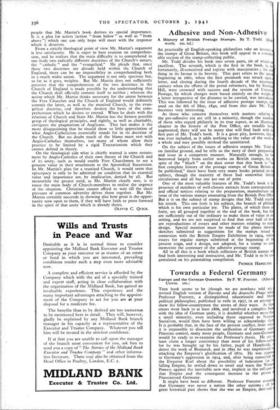Adhesive and Non-Adhesive
As practically all English-speaking philatelists take an interest 4 the stamps of Great Britain, this book will appeal to a considt: able section of the stamp-collecting public.
Mr. Todd divides his book into seven parts, six of which a:: excellent. The seventh, which is the first in the book, is, az fortunately, ill-conceived and replete with inaccuracies ; the only thing in its favour is its brevity. This part refers to the peric4 beginning in 1661, when the first postmark was struck upon letter, and closing during the fourth decade of the nineteen,' century when the efforts of the postal reformers, led by Rowlan, Hill, were crowned with success and the system of UniveN, Postage, by which charges were based entirely on the weight , a letter irrespective of the distance to be carried, was introduce, This was followed by the issue of adhesive postage stamps, fir, used on the 6th of May, 1840, and from this date Mr. Tod, becomes very interesting.
As those who concern themselves with matters relat;ng t the pre-adhesive era are still in a minority, though the number of those who regard philately in its true aspect, as an illustrated chapter in the history of the Post Office, are steadily being augmented, there will not be many that will find fault with the first part of Mr. Todd's book. It is a great pity, however, that was ever included, as it adds nothing to the value of the work ar a whole and may possibly mislead the uninitiated.
On the subject of. the issues of adhesive stamps Mr. Todd it on familiar ground, and he tells us the story of their preparatiot and issue in a competent manner. Naturally enough, he hn borrowed largely from earlier works on British stamps, for, n spite of the " blurb " on the dust cover that this book is "th first complete history of the postage stamps of Great Britain ti be published," there have been very many books printed on th subject, though the majority of these had somewhat limited circulations and all but one are out of print.
One of the most valuable features of Mr. Todd's book is the presence of numbers of well-chosen extracts from correspondenq and official notices relating to the preparation, manufacture and issue of the various stamps emanating from the British Post Offic But it is on the subject of stamp designs that Mr. Todd reached his zenith. This one feels is his subject, the branch of philateI which is his own particular joy. The plates, of which there at forty, are all grouped together at the end of the book, but the1 are sufficiently out of the ordinary to make them of value in an setting, and we are not surprised to find that over half of test are reproductions of essays and other matters relating to staml design. Special mention must be made of the plates showiq sketches submitted as suggestions for the stamps issued it connexion with the British Empire Exhibition in 1924, shill essays for regular stamps submitted at the beginning of th present reign, and a design, not adopted, for a stamp to corn memorate the centenary of the adhesive postage stamp.
All in all this is a book which collectors of British stamps will find both interesting and instructive, and Mr. Todd is to be COD gratulated on his painstaking compilation.
PATRICK HAMILTON.


























 Previous page
Previous page